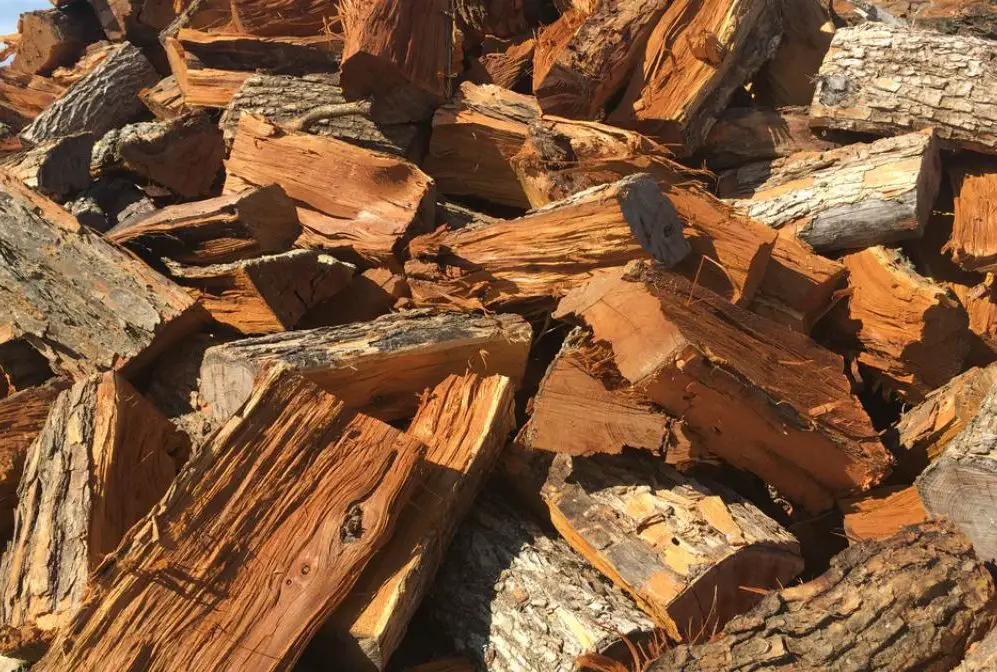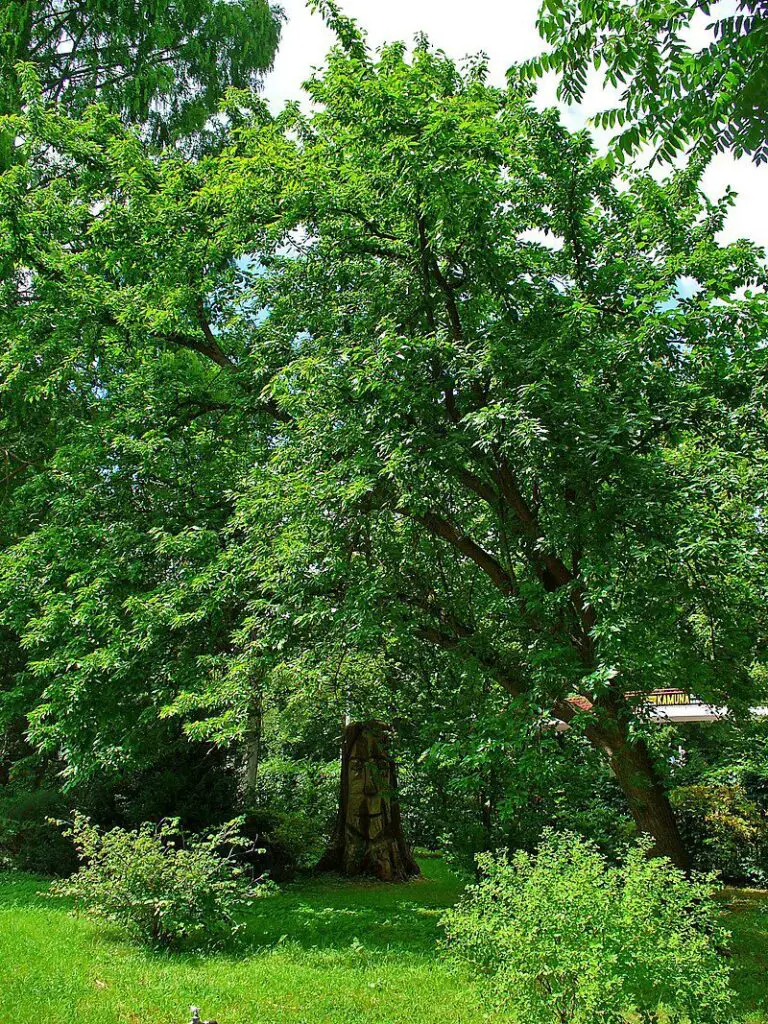Osage Orange firewood is an excellent firewood due to its high heat production, ease of splitting, and fast seasoning time, however it’s high sap content does generate a lot of smoke.
Osage Orange firewood is famous for producing the most heat of any wood species. It is a dense hardwood that burns hotter than any other firewood type, even the more popular oak. This is due to the high sap content, making it pop when burning. This also produces more smoke than alternatives, making it ideal for burning outdoors rather than heating your home in winter.
Table of Contents
Summary
- BTU: 32 million BTU/cord
- Weight: 5100 lb/cord green
- Seasoning Time: 6-12 months
- Splitting Difficulty: Low
- Sap Content: High
- Smoke: High
- Smell: Pronounced, Sweet Scent
Overall, osage orange is an excellent firewood that is one of the best in the world for burning outdoors. It produces the most heat of any hardwood and seasons quickly. Although originally it was only found in Texas, it has been grown in all continental states and has become more widely available. Its high density means you can stack more in standard stack dimensions and don’t need to purchase as much wood per unit of heat.
However, it does have some genuine problems – primarily the high sap content that leads to generating more smoke. It also burns so hot that it can warp wood stoves if you aren’t careful with the number of logs you put on the fire. For this reason, I generally limit my use of osage orange firewood to a few logs blended with oak and birch, or in a hot burning outdoor fire pit.

Heat Production
Osage orange produces the most heat of any firewood in the world, with 32 million BTU/cord. This is compared to the more popular oak at 27 million BTU/cord. It can produce so much heat and burn so hot that a fire built exclusively of osage orange can warp wood-burning stoves. If you have never used osage orange before, I strongly recommend keeping the fire significantly smaller than you normally would or blending it with colder burning woods.
You will also notice that osage orange burns with lots of pops and crackling as sap pockets ignite. If you are burning this indoors, then you should ensure you have a glass screen to avoid any sparks from burning anything outside the fireplace.
Smoke Production
Osage orange has a higher sap content than other hardwoods, which is what gives it such a high heat production. But this also leads to a higher smoke production. The smoke has a pronounced smell that I would describe as sweet. You hear some people smoking meats with osage orange, but it is not one of my go-to firewoods.
You should always ensure that osage orange firewood is seasoned correctly to remove as much sap as possible and limit the smoke generation.
Seasoning Time
You should season all of your firewood correctly to below 20% moisture, regardless of the type of wood. But this is especially true of woods with a high sap content, such as osage orange. Burning green firewood will produce a lot of smoke and burn erratically as it switches between the low-burning green wood and the high-burning sap pockets.
Thankfully, osage orange does season relatively quickly. This is partly due to the already low moisture content that the wood generally has due to its dry growing environment. It is also helped by the smaller diameter trunks that are generally cut into smaller logs.
I recommend stacking your firewood with plenty of airflow and a covering from rain to ensure it seasons as thoroughly as possible.
I personally recommend this General Tools Moisture Meter. It allows you to accurately gauge how wet your firewood is and whether it is sufficiently seasoned. Over time you can also see how quickly the moisture is dropping and how much longer you need to keep your firewood dropping until it is seasoned and ready to burn.
Press the sharp pins into the wood and you will quickly see the readout show the moisture ranging from 5% to 50%. It also has a Low/Mid/High indication depending on whether the wood is dry enough, so you don’t need to remember the actual values.

Burning Smell
The smell of osage orange smoke can be described as a potent, sweet smell. It doesn’t make my list of one of the best smelling firewood – in fact, if it is burnt green, then it can be quite pungent. People use osage orange firewood to smoke meat, but I think there are better options.
Creosote Buildup
Creosote is a type of black soot that can form in your chimney, generally when green softwood like pine is burnt. The uncombusted wood particles can lodge in the chimney and build up over time. Once this has formed enough mass, it can also catch fire and cause a fire in your chimney. Reducing the likelihood of creosote building up or removing it regularly is essential to minimize this risk.
Osage orange does produce more creosote than other hardwoods like oak because of its higher sap content. However, because it burns hot, unburnt particles are less likely to escape the fire. It still produces less creosote than softwoods.
Regardless of the type of wood you burn, I recommend cleaning your chimney annually.
Splitting
Osage orange is easy to split. It is generally relatively dry and doesn’t have many internal fibers to cut through. You will find that the tree is spindly and doesn’t grow particularly large, in terms of height or trunk diameter. This means the yield of firewood per tree is low. You will need to process thicker branches as well to ensure you get as much firewood as possible.
The trunks of osage orange trees only grow to around 6 inches in diameter, so the need for splitting isn’t difficult. This isn’t the kind of tree you will need a log splitter to handle.
Different Types/Species
Osage Orange is not related to an orange tree but is related to the mulberry tree. It comes with many different names, including mock orange, hedge apple, hedge, horse apple, monkey ball, monkey brains and yellow-wood. It is also known as bodark and bodock from the French bois d’arc, meaning bow-wood, after French settlers noticed Native Americans using the wood to make bows.
It is native to Texas and only grows as a smaller shrub up to 30-50 feet tall and 3-6 inches in diameter. It only grows in a very narrow band of South-Central USA, in the Red River drainage area through Texas, Oklahoma, and Arkansas. But it has been grown nationally throughout all the United States and even in parts of Canada.

Comparison to Other Woods
Here, I’ve taken some of the most popular firewoods to burn indoors and compared them to osage orange firewood.
Osage orange is an excellent firewood. It produces the most heat of any hardwood, leading to great cooking coals. The downsides are that it produces so much heat that it can warp stoves, and the smoke does make it less useful when burning indoors. I generally isolate my osage orange to either a blended fire indoors or for outdoor use.
| Firewood | Million BTU/Cord (source) | Ease of Splitting | Coals | Overall Quality |
| Green Ash | 20 | Easy | Good | Excellent |
| Maple | 25 | Easy | Excellent | Excellent |
| Bur Oak | 26 | Easy | Good | Excellent |
| Osage Orange | 32 | Easy | Excellent | Excellent |
Osage orange isn’t as commonly available as oak, but if you can get your hands on it, it is a real treat to add to your stockpile.
FAQs
Can you burn osage orange wood in a fire pit?
Yes, osage orange firewood is ideal for burning outdoors. It is the highest heat-producing wood in the world and will heat your entire campsite. It does produce a moderate amount of smoke due to its higher sap content which can pop and crackle, so give yourself enough distance away from the fireplace.
Can you burn osage orange wood in a wood stove?
Yes, osage orange can be burnt indoors; however, you should ensure adequate ventilation because of its high smoke generation. It also burns extremely hot, so you should build a smaller fire with fewer logs than you normally wood. Osage orange has been known to warp wood stoves because it burns so hot, so keep this in mind before you begin.
The wood must be fully seasoned before considering burning indoors to minimize the smoke generation and sap ignition.
How much does osage orange firewood cost to buy?
Osage orange is premium firewood and because it is not widely available, it costs more than alternative options. Depending on your location and season, it generally costs around $400 per cord. You should also be able to buy a bundle of osage orange firewood for around $6.
Final Thoughts
Osage orange is truly remarkable firewood. It produces so much heat that it can become a problem for your fireplace, wood stove, or chimney. It has a higher sap content that can lead to high smoke generation and creosote buildup, so it is essential that it is properly seasoned. I am always keen to get my hands on as much osage orange firewood as possible to add to my winter supplies for any outdoor burning I need.
